Ken Maynard (1895–1973) was one of the superstars among the film cowboys. He was most active from the 1920s to the 1940s.
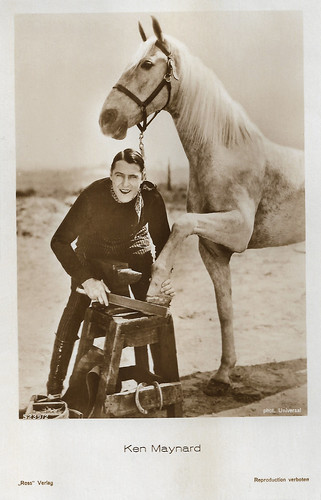
German postcard by Ross Verlag, no. 5239/2, 1930-1931. Photo: Universal.
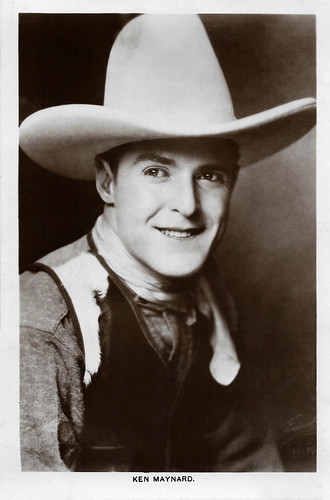
British postcard in the Picturegoer Series, London, no. 380. Photo: Roman Freulich.
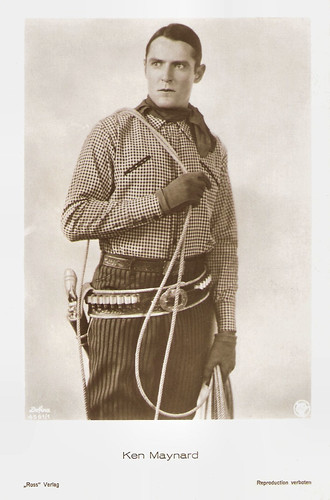
German postcard by Ross Verlag, no. 4561/1, 1929-1930. Photo: Defina / First National Pictures.
Kenneth Olin Maynard was born in 1895 in Vevay, Indiana, USA. His brother was the cowboy actor Kermit Maynard. Studio publicity incorrectly puts his birthplace at Mission, Texas. Ken spent his boyhood around Columbus, Indiana, and eventually attended, but not graduated from, Indiana University.
Reportedly, Ken Maynard began his career as a trick rider with the Buffalo Bill Wild West Show and later with the Ringling Brothers circus. When the circus was playing in Los Angeles, California, actor Buck Jones encouraged Maynard to try working in the movies.
His film debut, The Man Who Won (William A. Wellman, 1923) starring Dustin Farnum, was the first of many. He scored good notices with a secondary role in Janice Meredith (E. Mason Hopper, 1924) opposite Marion Davies.
Figuring it was better to be a big fish in a small pond, Ken signed with an independent low budget producer, J. Charles Davis and became a star in its low budget releases, $50,000 Reward (Clifford S. Elfelt, 1924) with Esther Ralston, and The Grey Vulture (Forrest Sheldon, 1926).
Maynard signed with First National Pictures and starred in some twenty silent Westerns. He remained with First National after it was sold off to Warner Brothers. Ken, at this point, was in his prime and at the top of his game with audiences. He was famous for the daredevil stunts he could enact with his white horse, Tarzan. These were photographed fairly close so audiences could see that Maynard was doing his own stunts.
Jack Backstreet at IMDb: "Few stars were ever as disliked within the business but held in such high regard by fans as Ken Maynard. To never have met Maynard was reportedly a blessing. And despite his innumerable personality shortcomings, no other western star of the period had so many opportunities thrown his way."

American Arcade card by Ex. Sup. Co., Chicago.

Dutch postcard by JosPe, no. 59. Photo: Croeze Bosman Universal. Ken Maynard and Jackie Hanlon in Parade of the West (Harry Joe Brown, 1930).
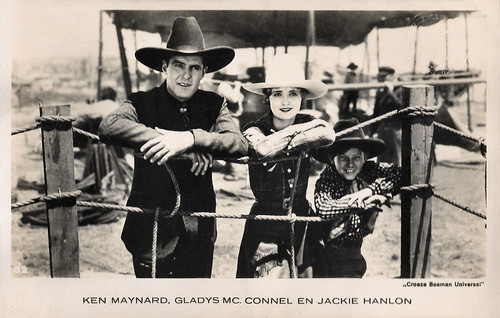
Dutch postcard by JosPe, no. 62. Photo: Croeze Bosman Universal. Ken Maynard, Gladys McConnell, and Jackie Hanlon in Parade of the West (Harry Joe Brown, 1930).
Ken Maynard lavished a fortune on women, fancy cars, and even had his own airplane. In 1929, he accepted a lucrative offer from Carl Laemmle to jump to Universal. Laemmle offered Ken his own company and creative control, which put him into the ranks of Hoot Gibson (then Universal's premier Western star), Tom Mix, and William S. Hart.
Maynard became the first singing cowboy in the movies. He recorded two songs for Columbia Records, 'The Lone Star Trail' and 'The Cowboy's Lament'. In one of his early sound films, Parade of the West (Harry Joe Brown, 1930), he sang the songs 'Down in Union County', 'The Old Chisholm Trail' and 'Sal's Got a Wooden Leg'.
For the 1931-1932 production season, the studio, riding high with its homegrown monster craze, opted to ditch Westerns altogether and Ken, who studio head Carl Laemmle had quickly grown to dislike, found himself on the wrong side of the studio's gates.
Other independent producers took a chance on the hotheaded star—among them Tiffany Productions and Sono Art-World Wide Pictures—before he returned to Universal in 1933. Maynard played several musical instruments and was featured that year on the violin in The Fiddlin' Buckaroo (Ken Maynard, 1933), and on the banjo in The Trail Drive (Alan James, 1933).
During the 1930s, he moved from one studio to another and finally went back to rodeo work. He returned to the screen in 1943 for low-budget Monogram Pictures in a new series called The Trail Blazers. He was teamed with fellow veteran stars Hoot Gibson and Bob Steele, and the trio offered action for the kids and nostalgia for their elders.
It wasn't long before Maynard's raging temperament again cost him the job; he liked Gibson but didn't like Steele, and left the series after seven films. One final film, Harmony Trail (Robert Emmett Tansey, 1944), was made by independent producer Walt Mattox. Ken Maynard retired for good except for bit parts. He made appearances at state fairs and rodeos. He owned a small circus operation featuring rodeo riders but eventually lost it to creditors.
Married multiple times, Manyard's last wife, Bertha Denham died in 1968 and he found himself living largely off meager Social Security checks. His last years were miserable. He was an alcoholic, who lived alone and in poverty in a trailer. Maynard never had any children.
More than 25 years after his last starring role, Maynard returned to the screen in two small roles in Bigfoot (Robert F. Slatzer, 1970) and The Marshal of Windy Hollow (Jerry Whittington, filmed in 1972 but never released).
In 1973, Ken Maynard died of stomach cancer largely forgotten at the Woodland Hills Motion Picture Home in Los Angeles. He was 77. Maynard was interred at Forest Lawn Cypress Cemetery in Cypress, California. He has a star on the Hollywood Walk of Fame at 6751 Hollywood Blvd.
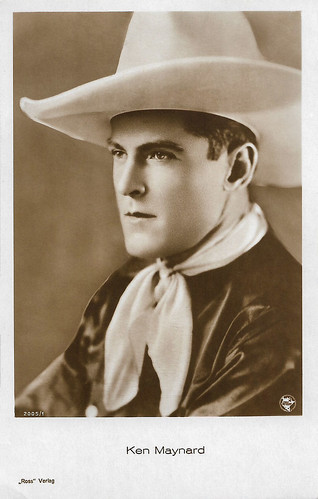
German postcard by Ross Verlag, no. 2005/1, 1927-1928. Photo: First National.
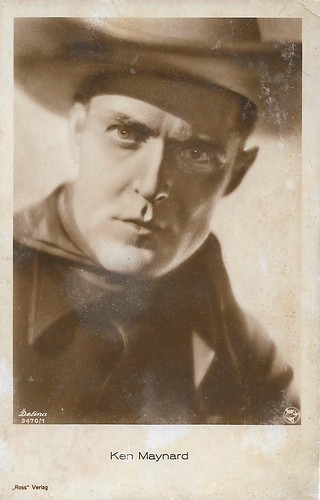
German postcard by Ross Verlag, no. 3470/1, 1928-1929. Photo: Defina / First National.

German postcard by Ross Verlag, no. 4370/1, 1929-1930. Photo: Defina / First National.
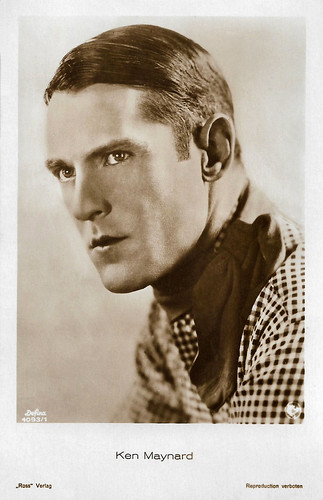
German postcard by Ross Verlag, no. 4393/1, 1929-1930. Photo: Defina / First National.
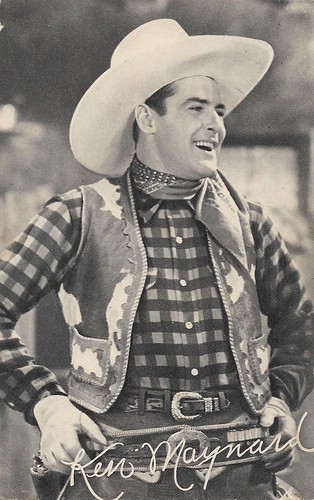
American postcard, c. 1935. Real Photogravure.
Sources: Jack Backstreet (IMDb), Ed Stephan (IMDb), Les Adams (IMDb), Wikipedia, and IMDb.

German postcard by Ross Verlag, no. 5239/2, 1930-1931. Photo: Universal.

British postcard in the Picturegoer Series, London, no. 380. Photo: Roman Freulich.

German postcard by Ross Verlag, no. 4561/1, 1929-1930. Photo: Defina / First National Pictures.
The first singing cowboy in the movies
Kenneth Olin Maynard was born in 1895 in Vevay, Indiana, USA. His brother was the cowboy actor Kermit Maynard. Studio publicity incorrectly puts his birthplace at Mission, Texas. Ken spent his boyhood around Columbus, Indiana, and eventually attended, but not graduated from, Indiana University.
Reportedly, Ken Maynard began his career as a trick rider with the Buffalo Bill Wild West Show and later with the Ringling Brothers circus. When the circus was playing in Los Angeles, California, actor Buck Jones encouraged Maynard to try working in the movies.
His film debut, The Man Who Won (William A. Wellman, 1923) starring Dustin Farnum, was the first of many. He scored good notices with a secondary role in Janice Meredith (E. Mason Hopper, 1924) opposite Marion Davies.
Figuring it was better to be a big fish in a small pond, Ken signed with an independent low budget producer, J. Charles Davis and became a star in its low budget releases, $50,000 Reward (Clifford S. Elfelt, 1924) with Esther Ralston, and The Grey Vulture (Forrest Sheldon, 1926).
Maynard signed with First National Pictures and starred in some twenty silent Westerns. He remained with First National after it was sold off to Warner Brothers. Ken, at this point, was in his prime and at the top of his game with audiences. He was famous for the daredevil stunts he could enact with his white horse, Tarzan. These were photographed fairly close so audiences could see that Maynard was doing his own stunts.
Jack Backstreet at IMDb: "Few stars were ever as disliked within the business but held in such high regard by fans as Ken Maynard. To never have met Maynard was reportedly a blessing. And despite his innumerable personality shortcomings, no other western star of the period had so many opportunities thrown his way."

American Arcade card by Ex. Sup. Co., Chicago.

Dutch postcard by JosPe, no. 59. Photo: Croeze Bosman Universal. Ken Maynard and Jackie Hanlon in Parade of the West (Harry Joe Brown, 1930).

Dutch postcard by JosPe, no. 62. Photo: Croeze Bosman Universal. Ken Maynard, Gladys McConnell, and Jackie Hanlon in Parade of the West (Harry Joe Brown, 1930).
On the wrong side of the studio's gates
Ken Maynard lavished a fortune on women, fancy cars, and even had his own airplane. In 1929, he accepted a lucrative offer from Carl Laemmle to jump to Universal. Laemmle offered Ken his own company and creative control, which put him into the ranks of Hoot Gibson (then Universal's premier Western star), Tom Mix, and William S. Hart.
Maynard became the first singing cowboy in the movies. He recorded two songs for Columbia Records, 'The Lone Star Trail' and 'The Cowboy's Lament'. In one of his early sound films, Parade of the West (Harry Joe Brown, 1930), he sang the songs 'Down in Union County', 'The Old Chisholm Trail' and 'Sal's Got a Wooden Leg'.
For the 1931-1932 production season, the studio, riding high with its homegrown monster craze, opted to ditch Westerns altogether and Ken, who studio head Carl Laemmle had quickly grown to dislike, found himself on the wrong side of the studio's gates.
Other independent producers took a chance on the hotheaded star—among them Tiffany Productions and Sono Art-World Wide Pictures—before he returned to Universal in 1933. Maynard played several musical instruments and was featured that year on the violin in The Fiddlin' Buckaroo (Ken Maynard, 1933), and on the banjo in The Trail Drive (Alan James, 1933).
During the 1930s, he moved from one studio to another and finally went back to rodeo work. He returned to the screen in 1943 for low-budget Monogram Pictures in a new series called The Trail Blazers. He was teamed with fellow veteran stars Hoot Gibson and Bob Steele, and the trio offered action for the kids and nostalgia for their elders.
It wasn't long before Maynard's raging temperament again cost him the job; he liked Gibson but didn't like Steele, and left the series after seven films. One final film, Harmony Trail (Robert Emmett Tansey, 1944), was made by independent producer Walt Mattox. Ken Maynard retired for good except for bit parts. He made appearances at state fairs and rodeos. He owned a small circus operation featuring rodeo riders but eventually lost it to creditors.
Married multiple times, Manyard's last wife, Bertha Denham died in 1968 and he found himself living largely off meager Social Security checks. His last years were miserable. He was an alcoholic, who lived alone and in poverty in a trailer. Maynard never had any children.
More than 25 years after his last starring role, Maynard returned to the screen in two small roles in Bigfoot (Robert F. Slatzer, 1970) and The Marshal of Windy Hollow (Jerry Whittington, filmed in 1972 but never released).
In 1973, Ken Maynard died of stomach cancer largely forgotten at the Woodland Hills Motion Picture Home in Los Angeles. He was 77. Maynard was interred at Forest Lawn Cypress Cemetery in Cypress, California. He has a star on the Hollywood Walk of Fame at 6751 Hollywood Blvd.

German postcard by Ross Verlag, no. 2005/1, 1927-1928. Photo: First National.

German postcard by Ross Verlag, no. 3470/1, 1928-1929. Photo: Defina / First National.

German postcard by Ross Verlag, no. 4370/1, 1929-1930. Photo: Defina / First National.

German postcard by Ross Verlag, no. 4393/1, 1929-1930. Photo: Defina / First National.

American postcard, c. 1935. Real Photogravure.
Sources: Jack Backstreet (IMDb), Ed Stephan (IMDb), Les Adams (IMDb), Wikipedia, and IMDb.
No comments:
Post a Comment